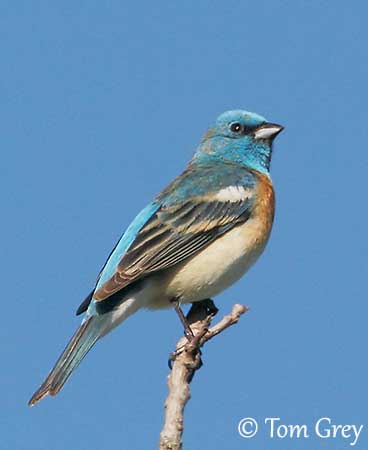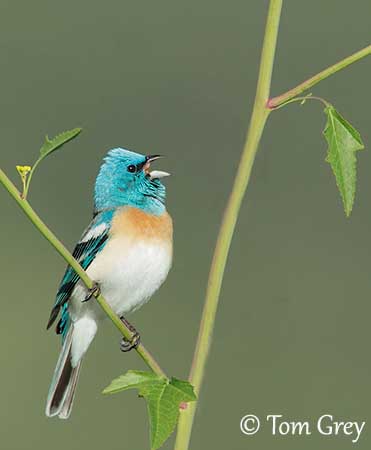
Fr: Passerin azuré
Ang: Lazuli Bunting
All: Lazulifink
Esp: Azulillo Lapislázuli
Ita: Papa lazuli
Nd: Lazuligors
Sd: Lazulifink
Photographer:
Tom Grey
Tom Grey's Bird Pictures
Text by Nicole Bouglouan
Sources:
HANDBOOK OF THE BIRDS OF THE WORLD Vol 16 by Josep del Hoyo- Andrew Elliot-David Christie – Lynx Edicions – ISBN: 9788496553781
BIRDS OF THE GREAT BASIN – by Fred A. Ryser - Univ of Nevada Pr -ISBN: 0874170796
FIELD GUIDE TO THE BIRDS OF NORTH AMERICA - National Geographic Society - ISBN: 0792274512
BirdLife International (BirdLife International)
All About Birds (Cornell Lab of Ornithology)
Bird Web (Seattle Audubon Society)
What Bird-The ultimate Bird Guide (Mitchell Waite)
Home page
Page Passeriformes Order
Lazuli Bunting
Passerina amoena
Passeriformes Order – Cardinalidae Family
INTRODUCTION:
The Lazuli Bunting’s name comes from the bright colour of the male’s hood, similar to the gemstone lapis lazuli.
The male is a good singer. Perched often high above the ground, it can sing through the heat of the day.
Closely related to the Indigo Bunting (P. cyanea) both species often hybridize where their ranges overlap.
This species is common to abundant in suitable habitats, by the Brown-headed Cowbird is a frequent brood-parasite, involving the loss of numerous chicks.

DESCRIPTION OF THE BIRD:
Biometrics:
Length: 13-14 cm
Wingspan: 20-23 cm
Weight: M: 13-20 g – F: 13-17 g
The adult male in breeding plumage has bright turquoise head, chin, throat and upper breast, becoming darker with blackish wash on mantle, back and scapulars. The rump is bright turquoise.
On the upperwing, the dark primaries show bluish edges on outer webs. Two white wingbars are formed by the white tips of median and greater wing-coverts.
On the tail, the feathers are dark with bluish wash, especially on outer webs.
On the underparts, the breast is cinnamon to chestnut-brown. Lower breast, belly, vent and undertail-coverts are pure white.
The short, conical bill has black upper mandible and pale bluish-grey lower mandible. The eyes are dark brown. Legs and feet are blackish.
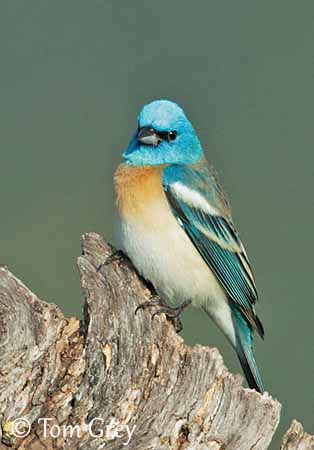
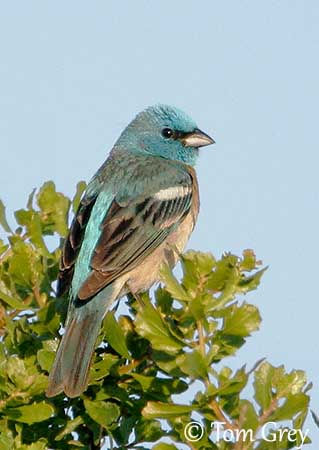
The male in non-breeding plumage has similar pattern, obscured by extensive buff feather tips.
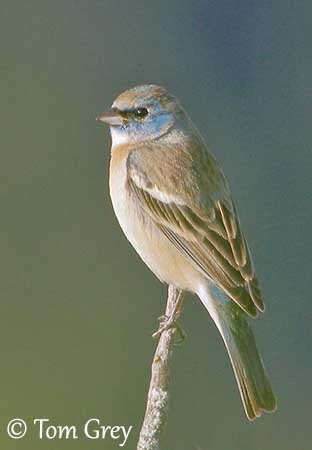
The female is greyish-brown above, with greyer or more bluish rump. The underparts are buffy-white with darker buff on breast and pale buffy grey on belly.
On the upperwing, the lesser coverts are tinged bluish. Two buffy-white wingbars are formed by the pale tips of median and greater coverts. The bare parts are similar to male.
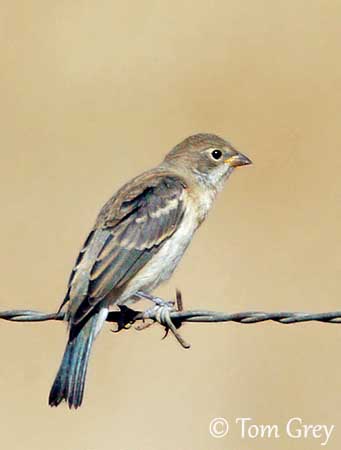
The juvenile is brown. Within the first year, some blue or orange feathers appear in young male.
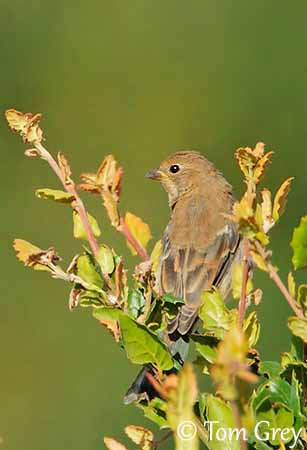
RANGE:
The Lazuli Bunting breeds from SW Canada to N Texas, N New Mexico and Arizona, and extreme NW Mexico (NW Baja California).
It migrates to SE Arizona, S through W Mexico to NW Oaxaca.
HABITAT:
The Lazuli Bunting often frequents dry, brushy ravines and slopes, wooded valleys and also cleared areas, open scrub and weedy pastures. This species can be seen at high elevation, up to 3000 metres in Sierra Nevada of California, and up to 2000/2400 metres in Mexico.
During winter, it frequents overgrown fields, thorn-forest and roadsides.
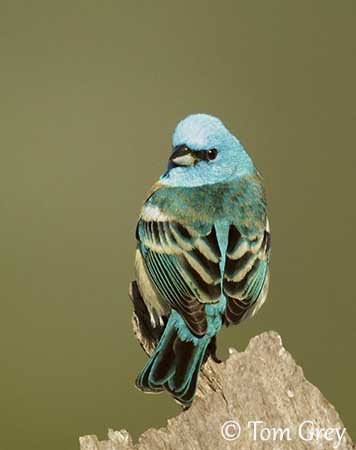
CALLS AND SONGS: SOUNDS BY XENO-CANTO
The Lazuli Bunting male sings from exposed song perches to establish the territory. The song is high-pitched, with some syllables added or dropped, although the general theme does not change. It is repeated several times at intervals of 10-12 seconds. The song is described as follows: “see-see-see, sweert, sweert, zee, see, sweet, zeer, see-see”.
There are considerable variations of the song type, but each individual has its own song which remains fairly constant.
When excited, it gives a short “chip” note. While mating, the male utters a “tseep” and the female a “ti-ti-ti-ti”. When alarmed or threatened, they give a “seet” and a loud, distress call “eeee” if the nest is threatened.
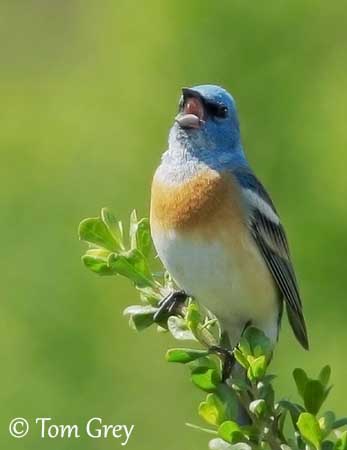
BEHAVIOUR IN THE WILD:
The Lazuli Bunting feeds primarily on seeds from weeds and trees, but it also takes fruits and seeds from various other plant species. During spring and summer, it hunts for invertebrates such as caterpillars, small spiders, and insects including Hemiptera, Coleoptera and Formicidae.
The Lazuli Bunting forages alone or in pairs, and in small groups outside the breeding season. When foraging on the ground, it picks up the seeds, and also perches in grasses to eat the seedheads.
It gleans insects from leaves, and performs short flights and flycatching from perches.
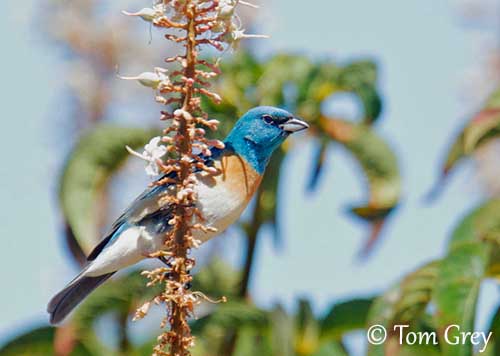
They are monogamous, but the males can be occasionally polygamous. They are fairly aggressive at the beginning of the breeding season while establishing the territories. Chases and territorial disputes often occur.
The courtship displays are poorly known, but we can suggest that the bright-coloured plumage pattern of the male is enhanced by postures and movements. Courtship feeding occurs in the later stages of pair formation. Song flights are probably performed too.
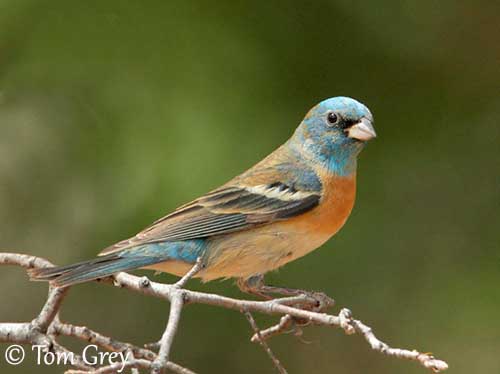
The Lazuli Bunting is migratory and travels in flocks and by night. It leaves the breeding grounds between July and mid-August. The autumn migration includes an interruption of one month for the moult which usually occurs in S Arizona, SW New Mexico and S Baja California. Then, they reach S USA and W Mexico for wintering.
They return to their breeding grounds between early April and early June.
The Lazuli Bunting performs short flights and flycatching when foraging for insects. During migrations, the flight is strong and direct.
REPRODUCTION OF THIS SPECIES:
The breeding season occurs between May and September, with a peak in June-August.
The female selects the nest-site and builds the nest, a cup-shaped structure concealed in the vegetation, between one and two metres above the ground.
The nest is made with rootlets, grasses and bark strips. The outer part is covered with spider web or caterpillar silk. The cup is lined with soft grasses and animal hair.
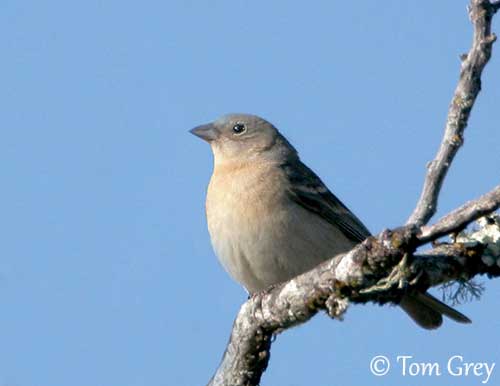
The female lays 3-4 pale, unmarked eggs, and incubates during 11-14 days. The chicks are fed by both parents, but mainly by female. The young fledge 9-11 days after hatching, sooner if they are disturbed. They still depend on parents for two weeks after fledging.
The male may care the young alone while the female initiates a second brood.
This species is often parasitized by the Brown-headed Cowbird, especially in California and W Montana. But brood loss may vary according to the hatching. If the buntings hatch 2-3 days before the cowbird, they are able to compete for food.
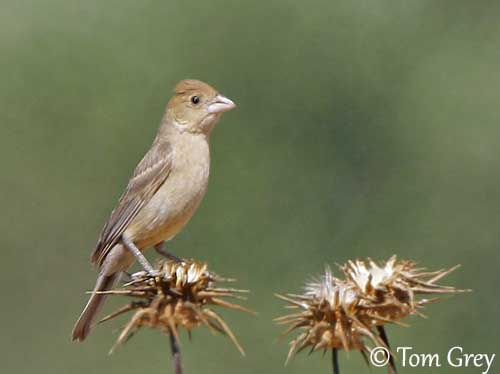
PROTECTION / THREATS / STATUS:
The Lazuli Bunting is common to abundant in suitable habitat in most parts of the range. This species is frequently taken as cagebird, and suffers heavy brood parasitism in some parts of the distribution.
But currently, the Lazuli Bunting is not threatened and evaluated as Least Concern, with populations slightly increasing.
